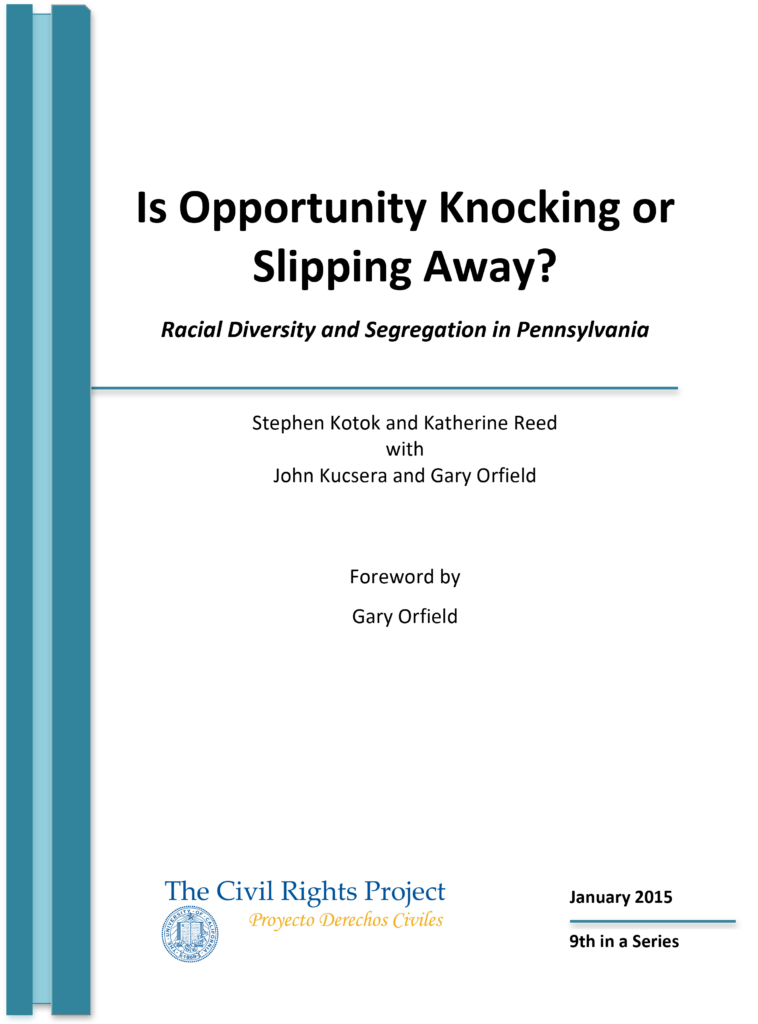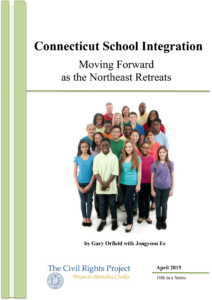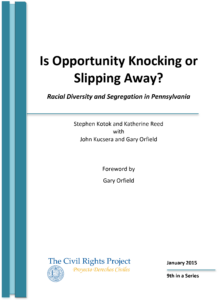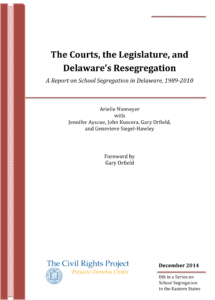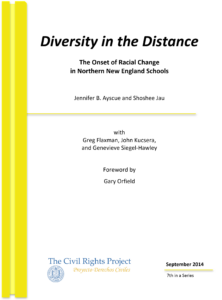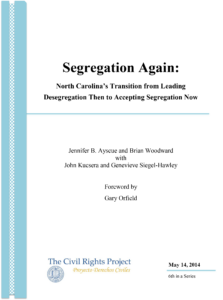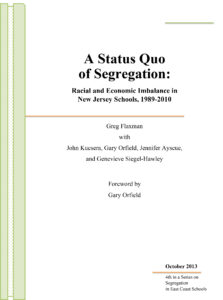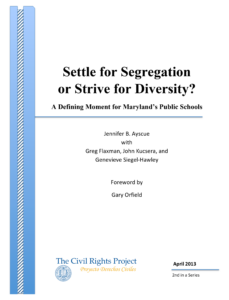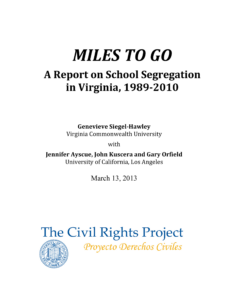Executive Summary
Historically, Pennsylvania has struggled to integrate its public schools, especially with much of the racial diversity concentrated in urban regions. Starting in the 1960s, the Pennsylvania Human Relations Commission (PHRC) was the state’s enforcing body to combat school desegregation, but since the early 1980s, when it comes to education, the PHRC has shifted its focus away from segregation towards other forms of discrimination such as unequal discipline, lack of services for disabled students, and sexual harassment.
In the past, the Commission took on several school segregation cases in the largest urban areas of Pennsylvania, including Philadelphia and Pittsburgh and enforced the state rules in smaller communities in order to integrate public schools. The desegregation cases in Pennsylvania ran the gamut from state court mandates to locally devised voluntary plans and demonstrated that challenges remained to integrating Pennsylvania’s public schools. Evidence from this report shows that although segregation in Pennsylvania persists and is increasing according to some measures, there is little action aimed at creating more racially diverse schools.
Pennsylvania, like much of the United States, has experienced increasing racial diversity in its public schools over the last two decades. This report investigates trends in school segregation in Pennsylvania over the last two decades by examining concentration, exposure, and evenness measures by both race and class. After exploring the overall enrollment patterns and segregation trends at the state level, this report focuses on Pennsylvania’s major metro areas, Philadelphia and Pittsburgh, to analyze similar measures of segregation for each metropolitan area. These two metropolitan areas differ greatly in their demographic composition, with Pittsburgh being one of the whitest major metropolitan areas in the country, having virtually no Latino or Asian students, while Philadelphia reports a much more diverse population. However, we find that both metropolitan areas face similar challenges in terms of segregation between different school districts.
Major findings in this report include:
Pennsylvania (statewide)
- The white share of the total public school enrollment decreased from 82.8% in 1989-1990 to 71.8% in 2010-2011, a decline of 11 percentage points. During the same time, the non- white share of public school enrollment increased, most notably due to the sizable increase in Latino share of public school enrollment. The state is far whiter than the U.S. as a whole.
- The typical black student attends a school with 65.8% low-income students, and the typical Latino student attends a school with 62.6% low-income students, as compared to the typical white student, who attends a school that was 30.3% low-income, indicative of extreme racial disparities in exposure to poverty.
- Of students who attended intensely segregated schools (90-100% minority) in 2010-2011, 85.1% were low-income, and among those who attended apartheid schools (i.e., 99-100% minority), 86.1% were low-income, both of which represent increases from 1999-2000. These figures suggest high and overlapping segregation by race and poverty.
- Since 1989-1990, the share of majority minority and intensely segregated schools has more than doubled to 21% and 11% respectively, and the share of apartheid schools increased from 3.5% to 4.8%.
- By 2010-2011, the percent of black students in majority minority (50-100% minority) schools had increased from 68.7% in 1989-90 to 71.7%, and a large share of Latinos (60.9%) attended such schools as well.
- In 2010-2011, the typical black student in Pennsylvania attended a school that was 29.5% white, and the average Latino students attended a school that is 39.0% white, though whites make up 71.8% of total public school enrollment. On the other hand, the typical white student attended a school that was 85.1% white.
Metro Philadelphia
- The white share of Philadelphia’s public school enrollment decreased from 59.8% in 1989-1990 to 52.8% in 2010-2011, and the Latino share of enrollment increased from 4.8% to 9.3%.
- The typical black student in the Philadelphia metro attended a school with 70.9% low- income students and the typical Latino student attended a school with 66% low-income students, more than three times the share of low-income students in schools attended by the typical white student (21.2%), a higher disparity than that found in nearby states.
- In 2010-2011, majority minority schools enrolled 76.2% low-income students, intensely segregated schools enrolled 84.6% low-income students, and apartheid schools enrolled 86.0% low-income students.
- Majority minority schools represented 44.5% of metro Philadelphia schools, intensely segregated schools represented 30.9%, and in 2010-2011, apartheid schools represented17.1% of all Philadelphia metro schools.
- In 2010-2011, 38.2% of Philadelphia’s black students and 13.5% of Latino students were enrolled in intensely segregated schools.
- In 2010-2011, even though the overall white student enrollment in metropolitan Philadelphia was 52.8%, the typical black student in the metro attended a school with 17.6% white students and the typical Latino attended a school with 29.8% white students while the typical white student attended a school that was 76.8% white.
- In 2010-2011, the average school was 42% less diverse than the entire intrastate metropolitan area of Philadelphia, and over 75% of this difference in diversity between the average public school and the entire metro area was due to segregation across district boundaries rather than within districts.
- All ten of the highest enrolling districts in the metro area that were open in all time periods examined had a smaller proportion of white students enrolled in 2010-2011 than in 1989-1990, but the white share of the enrollment only dropped more than 10 perentage points in four of the districts (North Penn, Pennsbury, Upper Darby, and Spring-Ford Area).
- Over the last two decades, only two of the ten highest enrolling districts in the Philadelphia area – North Penn and Upper Darby – transitioned from being predominantly white to diverse or predominantly non-white, while the other seven predominantly white districts in metro Philadelphia remained predominantly white.
Metro Pittsburgh
- The white share of Pittsburgh’s public school enrollment decreased from 85.3% in 1989- 1990 to 81.7% in 2010-2011 and during the same time period the share of students from other racial/ethnic groups remained relatively stable. Thus, compared to Philadelphia, Pittsburgh has a much smaller proportion of minority students.
- The typical white student in Pittsburgh attended a school that is 28.6% low-income while the typical black student attended a school that is 62.7% low-income, concentrating disadvantage through segregation by race and class.
- Very high and increasing percentages of low-income students are enrolled in majority minority and intensely segregated schools, indicating that Pittsburgh’s students are segregated by race and class. The share of low-income students in intensely segregated schools increased from 76.9% in 1999-2000 to 88.2% in 2010-2011.
- Over the last two decades, the share of majority minority schools has increased from 10.8% to 15.2% in Pittsburgh, and intensely segregated schools accounted for 3.8% of schools in 2010-2011.
- In 2010-2011, 59.2% of blacks were enrolled in majority minority schools and 17.2% attended intensely segregated schools.
- In 2010-2011, the typical black student attended a school with 43.4% white students even though white students made up 81.7% of the overall enrollment in the Pittsburgh metro area. The typical white student attended a school that was 88.5% white. Despite the potential for integration due to a high proportion of white students in the Pittsburgh metro, black students are still dramatically underexposed to their white peers.
- In 2010-2011, the average school was 34% less diverse than the entire intrastate metropolitan area of Pittsburgh, and 94% of this difference in diversity between the average public school and the entire metro area was due to segregation across district boundaries rather than within districts.
- All ten of the highest enrolling districts in the metro that were open in all time periods had a smaller share of white students enrolled in 2010-2011 than in 1989-1990.
- In 1989-1990, all of the highest enrolling districts were predominantly white except for Pittsburgh, which was diverse. In 2010-2011, nine of the ten highest enrolling districts remained predominantly white, but Pittsburgh had transitioned from diverse to predominantly non-white.
By and large, these findings highlight the deepening segregation by race and class of Pennsylvania’s public school students. These trends toward increasing segregation for the last two decades will undoubtedly have lasting negative impacts both for minority communities and for the community at large. Decades of social science research indicate that segregated schools are strongly related to many forms of unequal educational opportunity and outcomes. Minority segregated schools have fewer experienced and less qualified teachers, high levels of teacher turnover, inadequate facilities and learning materials, high dropout rates, and less stable enrollments. Conversely, desegregated schools are linked to profound benefits for all students. Desegregated learning environments are related to improved academic achievement for minority students with no corresponding detrimental impact for white students, improved critical thinking skills, loftier educational and career expectations, reduction in students’ willingness to accept stereotypes, heightened ability to communicate and make friends across racial lines, and high levels of civic and communal responsibility.
This report provides multiple recommendations for those who are seeking to address resegregation in Pennsylvania’s schools:
- The Pennsylvania Human Relations Commission should revive their role to promote school desegregation given their mission to fight education discrimination.
- Given high levels of between-district segregation, Pennsylvania should develop policies that promote and facilitate interdistrict school choice and transfer.
- Pennsylvania needs to develop state-level policies that focus on reducing racial isolation and promoting diverse schools. Such policies should address how districts can create student assignment policies that foster diverse schools, discuss how to recruit a diverse teaching staff, provide a framework for developing and supporting inter-district programs, and require that districts report to the state on diversity-related matters for both public and charter schools.
- State and local officials should work to promote diversity in charter school enrollments and consider pursuing litigation against charter schools that are receiving public funds but are intentionally segregated, serving only one racial or ethnic group, or refusing service to English language learners.
- Fair housing agencies and state and local housing officials need to regularly audit discrimination in housing markets and ensure that potential homebuyers are not being steered away from areas with diverse schools.
- Local fair housing organizations should monitor land use and zoning decisions and advocate for low-income housing to be set-aside in new communities that are attached to strong schools.
- Housing officials need to strengthen and enforce site selection policies and counseling of Section 8 and voucher tenants about choices so that they support integrated schools. Schools—both public and charter—should not be built or opened in racially isolated areas of the district.
- Local educational organizations and neighborhood associations should vigorously promote diverse communities and schools as highly desirable places to live and learn.
- Efforts should be made to foster the development of suburban coalitions to influence state-level policy-making around issues of school diversity and equity.
- Districts should develop policies that consider race among other factors in creating diverse schools.
- Magnet schools and transfer programs across district borders should also be used to promote more racially integrated schools.
- Local organizations and parents should ask the school board to address and correct noncompliance and violations of long-standing desegregation plans.
- Interested citizens and elected officials should support judicial appointees who understand and seem willing to address the history of segregation and minority inequality and appear ready to listen with open minds to sensitive racial issues that are brought into their court rooms.
It is necessary that Pennsylvania now take steps to reverse these trends by being proactive in addressing the segregated nature of its public schools. The state’s students of color are experiencing high and rising levels of segregation. Given the trends presented in this report, it is likely that segregation will only continue to intensify if nothing is done to address it.
This report is part of a special series, “School Segregation Trends in the Eastern States.” These studies explore trends in enrollment and school segregation patterns from 1989 to 2010 at the state and regional levels, including various metro areas for each state. The reports also document the history of school desegregation in each state and across its geographic regions, including key desegregation cases and remedies, when applicable.
In compliance with the UC Open Access Policy, this report has been made available on eScholarship:
